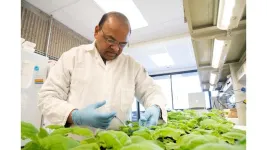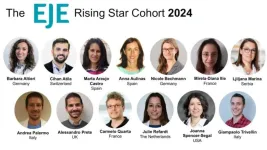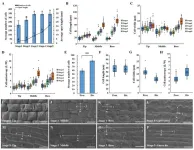(Press-News.org) Researchers have found water vapour in the disc around a young star exactly where planets may be forming.
Water is a key ingredient for life on Earth and is also thought to play a significant role in planet formation, yet, until now, astronomers have never been able to map how water is distributed in a stable, cool disc — the type of disc that offers the most favourable conditions for planets to form around stars.
For the first time, astronomers have weighed the amount of water vapour around a typical planet-forming star.
The new findings were made possible thanks to the Atacama Large Millimeter/submillimeter Array (ALMA) - a collection of telescopes in the Chilean Atacama Desert. The University of Manchester’s Jodrell Bank Centre for Astrophysics hosts the UK ALMA Regional Centre Node (UK ARC) which supports UK astronomers using ALMA.
Dr Anita Richards, Senior Visiting Fellow at The University of Manchester and previously a member of the UK ARC, played a key role in the group verifying the operation of the 'Band 5' receiver system, which was essential for ALMA to produce the detailed image of the water.
Dr Richards said: "Directly measuring the amount of water vapour where planets are forming takes us a step closer to understanding how easy it could be to make worlds with oceans - how much water is attached to the agglomerating rocks, or is it mostly added later to an almost-fully-formed planet? This sort of observation needs the driest possible conditions and could only be made in such detail using the ALMA array in Chile."
The observations, published today in the journal Nature Astronomy, reveal at least three times as much water as in all of Earth’s oceans in the inner disc of the young Sun-like star HL Tauri, located 450 light-years away from Earth in the constellation Taurus.
Stefano Facchini, an astronomer at the University of Milan, Italy, who led the study, said: “I had never imagined that we could capture an image of oceans of water vapour in the same region where a planet is likely forming.”
Co-author Leonardo Testi, an astronomer at the University of Bologna, Italy, added: “It is truly remarkable that we can not only detect but also capture detailed images and spatially resolve water vapour at a distance of 450 light-years from us.”
These observations with ALMA, which show details as small as a human hair at a kilometre distance, allow astronomers to determine the distribution of water in different regions of the disc.
A significant amount of water was found in the region where a known gap in the HL Tauri disc exists – a place where a planet could potentially be forming. Radial gaps are carved out in gas- and dust-rich discs by orbiting young planet-like bodies as they gather up material and grow. This suggests that this water vapour could affect the chemical composition of planets forming in those regions.
But, observing water with a ground-based telescope is no mean feat as the abundant water vapour in Earth’s atmosphere degrades the astronomical signals.
ALMA, operated by European Southern Observatory (ESO), together with its international partners, sits at about 5000 metres elevation and is built in a high and dry environment specifically to minimise this degradation, providing exceptional observing conditions. To date, ALMA is the only facility able to map the distribution of water in a cool planet-forming disc.
The dust grains that make up a disc are the seeds of planet formation, colliding and clumping into ever larger bodies orbiting the star. Astronomers believe that where it is cold enough for water to freeze onto dust particles, things stick together more efficiently — an ideal spot for planet formation.
Members of the UK ARC are contributing to a major upgrade of ALMA, which with ESO’s Extremely Large Telescope (ELT) also coming online within the decade, will provide even clearer views of planet formation and the role water plays in it. In particular METIS, the Mid-infrared ELT Imager and Spectrograph, will give astronomers unrivalled views of the inner regions of planet-forming discs, where planets like Earth form.
END
Astronomers reveal a new link between water and planet formation
2024-02-29
ELSE PRESS RELEASES FROM THIS DATE:
Plant biologists identify promising new fungicides
2024-02-29
A promising new fungicide to fight devastating crop diseases has been identified by researchers at the University of California, Davis. The chemical, ebselen, prevented fungal infections in apples, grapes, strawberries, tomatoes and roses and improved symptoms of pre-existing fungal infection in rice.
Fungal pathogens account for almost a quarter of global crop losses. In the United States, these losses amount to around $150 billion per year. However, fungicide development has been slow for the past 50 years, largely because researchers have had difficulty identifying molecular pathways to target. In a new study published Feb. 29 in ...
Researchers uncover a potential genetic marker associated with better survival outcomes in patients with head and neck cancer
2024-02-29
FINDINGS
Researchers from the UCLA Health Jonsson Comprehensive Cancer Center show for the first time that a gene usually linked to giant axonal neuropathy, a rare and severe neurological condition, also plays a role in inhibiting aggressive tumor cell growth in head and neck cancers.
The team found when the specific genetic variant (GAN gene exon 8 SNP T allele) of the GAN gene isn't present, it leads to the production of certain proteins that make cancer cells more likely to spread and become resistant to treatment.
These findings suggest that the presence of the genetic variant and higher expression of the GAN gene product gigaxonin may contribute ...
European Society for Endocrinology’s European Journal of Endocrinology announces “Rising Stars” in endocrine research for 2024-26
2024-02-29
Thirteen exceptional endocrine researchers from across Europe and the US have been selected as the 2024-26 cohort of the EJE Rising Star Editorial Board by the European Journal of Endocrinology (EJE), a journal published by the European Society of Endocrinology (ESE).
This prestigious opportunity is given to individuals selected by EJE Editors who show promise, achievement and trajectory as leading clinical and translational researchers in endocrinology, with high potential to serve as future editors of EJE.
Through the Rising Stars Programme, awardees are granted the following:
membership ...
Hai-quan Huang's research team at Southwest Forestry University has revealed the cellular and molecular basis of the spur development in Impatiens uliginosa
2024-02-29
As an important reproductive organ of angiosperms, flowers have clear purposefulness and adaptive significance in their various characteristics. As a typical floral evolutionary feature, the floral spur is a tubular structure extending from the petal, which has undergone several independent evolutions in angiosperms (e.g., Impatiens, Aquilegia, Linaria, etc.). Meanwhile, it plays a vital role in the pollination process because of its properties of secreting and storing nectar. In addition, the morphology (length, diameter, degree of distortion), ...
New research reveals that lockdowns had an impact on gut microbes and allergies in newborns
2024-02-29
29 February 2024: Lockdowns imposed during the COVID-19 pandemic had an impact on the gut microbiome development of babies born during these periods according to new research from RCSI University of Medicine and Health Sciences, Children’s Health Ireland and APC Microbiome Ireland (APC), a world leading SFI Research Centre, based in University College Cork.
Our gut microbiome, an ecosystem of microbes that live in our digestive tract, plays an essential role in human health. The study published in Allergy is the first to specifically explore the gut health of newborns in the pandemic. ...
Seeing the wood for the trees: how archaeologists use hazelnuts to reconstruct ancient woodlands
2024-02-29
If we could stand in a landscape that our Mesolithic ancestors called home, what would we see around us? Scientists have devised a method of analyzing preserved hazelnut shells to tell us whether the microhabitats around archaeological sites were heavily forested or open and pasture-like. This could help us understand not only what a local environment looked like thousands of years ago, but how humans have impacted their habitats over time.
“By analyzing the carbon in hazelnuts recovered from archaeological sites in southern Sweden, from Mesolithic hunter-gatherer ...
EU-funded Biodiversity Community Integrated Knowledge Library (BiCIKL) project sums up outcomes and future prospects at a Final GA in Cambridge
2024-02-29
The city of Cambridge and the Wellcome Campus hosted the Final General Assembly of the EU-funded project BiCIKL (acronym for Biodiversity Community Integrated Knowledge Library): a 36-month endeavour that saw 14 member institutions and 15 research infrastructures representing diverse actors from the biodiversity data realm come together to improve bi-directional links between different platforms, standards, formats and scientific fields. Consortium members who could not attend the meeting in Cambridge joined the meeting remotely.
The ...
Detailed study demonstrates how pulse oximeters significantly overestimate oxygen readings in people with darker skin tones
2024-02-29
Pulse oximeters – one of the most common medical devices used in global healthcare – can provide significantly overestimated oxygen saturation readings in people with darker skin tones, according to the most comprehensive study ever to explore the issue.
Published in the British Journal of Anaesthesia, the new study is based on a systematic review of previous research into the use of the devices, and examined 44 studies dating from the mid-1970s to the present day.
In the course of that, researchers assessed more than 733,000 oxygen saturation readings taken from over 222,000 people – including almost ...
Virtual walking by synthesizing avatars into a 360-degree video
2024-02-29
Overview:
Researchers at the Toyohashi University of Technology and the University of Tokyo developed a system that provides a virtual walking experience to a seated person by real-time synthesis of a walking avatar and its shadow on a 360-degree video with vibrations to the feet. The shadow of the avatar induces an illusory presence of their body. In the future, it is expected to provide an immersive experience for any recorded medium with a virtual embodiment.
Details:
Walking is a fundamental activity for humans ...
How to make difficult-to-cut materials and components “easy-to-cut”?
2024-02-29
Difficult-to-cut materials such as titanium alloys, high-temperature alloys, metal/ceramic/polymer-matrix composites, hard and brittle materials, as well as geometrically complex components such as thin-walled structures, micro channels and complex surfaces, are widely used in aerospace community. Nevertheless, many problems including severe and rapid tool wear, low machining efficiency, and poor surface integrity exist in mechanical machining. How to efficiently and precisely process these materials and components, i.e., make difficult-to-cut ...





